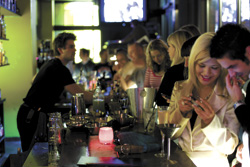Peer inside Kurrent Restaurant and Bar on a Friday night, and the crowd flanking the cocktail bar is four deep. Women in battle heels and clinging tops sip from stainless-steel martini glasses, while gay men holding dewy highballs work $60 haircuts and slim-hipped pants (so do the straight men, for that matter). There’s a scent of cologne in the air, a crispness to the shirts and once-over looks that you don’t see in many Capitol Hill bars; from the night Kurrent opened this August, the place has made its own scene.
However, more than a month after its inaugural service, the black tables surrounding mine emanated a cool emptiness. Our waiter, who could have been working in the men’s department at Barney’s, handed out menus and delivered a five-minute lecture in a confident, nightly-news baritone: “We’re still sorting out the kinks in our menu, replacing the dishes that don’t work with ones that do.” He then reeled off a list of new dishes and substitutions, invalidating a good third of the menu.
The original menu, compiled by chef-owner Matt Baer—whose Seattle cooking experience includes Marco’s Supperclub, Salty’s, and the Bell Harbor International Conference Center—was predominantly Asian in tone; it’s not surprising given that co-owners Vin and Thai Lam and Van Hong come from the family behind Lam Seafood Market in the ID. But the revamped menu shifts back toward the West. In this vein, we ate a fine salad of spinach, apples, and blue cheese dressed in a vinaigrette with a discreet splash of smoky bacon fat, and an oily but decent “zucchini Parmesan” stacked into a tower, slabs of breaded and deep-fried squash layered with a mild tomato sauce and a bit of mozzarella.
The occidental shift may have been an improvement, given the flavor of the Asian-fusion dishes: An “appeteaser” (Kurrent’s words, not mine) called “chicken pops” were cubes of chicken breast dredged lightly in rice flour and deep-fried, then rolled in a ginger-infused sugar syrup. I think the pops were supposed to play off of sesame chicken or General Tso’s, but the chef didn’t think his idea through enough to remember that breast meat has zero flavor and ginger syrup only has one. A salmon fillet crusted in crushed rice noodles was poised on top of rice cooked with so many kaffir lime leaves that their fragrance became an unpleasant aftertaste. Though the salmon was cooked just right, a vanilla beurre blanc sauce surrounding it needed more acid to counterbalance the rich, meaty fish.
At Kurrent’s inception, bar manager James MacWilliams, who worked with Baer at Salty’s, put together two pages of experimental house cocktails involving things like shishito peppers, tobiko, and quinine powder. A bewitchingly herbal Tarragon Swizzle with sparkling wine, gin, and tarragon syrup was one of the loveliest champagne cocktails I’ve tasted in years. But a “cigar and vanilla wood-smoked cherry” dropped into an El Manhattano made the drink taste like a firefighter’s uniform. Clearly, the place needed more time to find itself.
Returning a month later, I encountered much the same scene: The man in black behind Kurrent’s bar, with its 2-inch-wide strip of ice running down the center and 60-some vodkas, had enough customers around him to stay busy. When my guest and I told him we’d love some dinner, he had to dodge back to the kitchen to bring out our waiter, who’d been idling in wait of customers. The guy turned out to be a quick and observant pro; his duties were made easier by the fact that he had a shorter list of 86’d items to recite.
Kurrent’s booths, with their translucent, lighted plastic walls, seemed like the perfect place to hang out with an entourage and an eight ball of coke. For that matter, so did the lounge area flanking a wall of blue fire, the standing-height bar tables with chrome and white-leather stools, and the Blondie memorial corner illuminated by fluorescent-light stripes.
The food came displayed with frilly fried garnishes on asymmetrical white plates seemingly transported to Earth in Mork’s space-egg. Once again, it was big on style, middling on substance. The “chop-chop” salad was composed of carefully arranged lettuce, precisely diced cucumbers and tomatoes, generous chunks of blue cheese, a hard-boiled egg, and chicken breast cubes—everything a man could want, except dressing. A juicy half-chicken served with soft, sweet garlic cloves over fresh pasta was wreathed in translucent, crumbly, deep-fried spinach leaves that were impossible to eat. Baer cold-smoked a fat slice of pork loin so that it was lightly seasoned by smoke, then roasted the meat a juicy medium. Too bad I couldn’t taste the “lemongrass brine” advertised on the menu, or any salt for that matter, and the chop was displayed on a bed of “shoestring potatoes” so thin and over-fried that they disintegrated beneath the weight atop.
Man loves his Fryolator like a Hummer loves gas. The machine, though, was responsible for most of the amateurish touches in the meal—far too many, given the $17–$25 entrée prices. My last taste of Kurrent’s food summed it all up: a hot banana-chocolate spring roll covered in burned splotches where the chocolate had oozed out into the oil. Laid on top, like a halfhearted apology, was a sprig of wilted mint.
So why, then, is Kurrent a restaurant instead of a bar? Bars succeed or fail on their atmosphere, while restaurants have to deliver good service and food, too. Kurrent’s got a distinctive look and a clientele eager to bask in it. If the food doesn’t smarten up, atmosphere alone will have to do.






